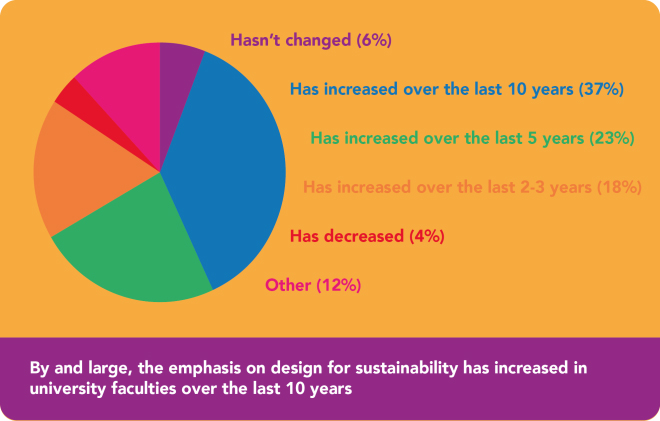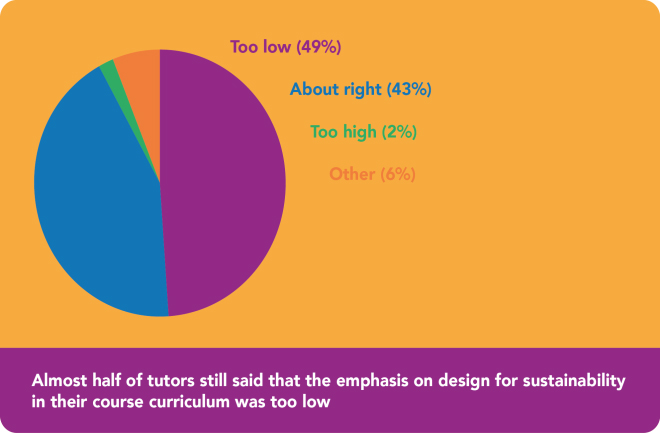Earlier this year I interviewed a series of design tutors and students around the country as part of a piece of research for the RSA’s Student Design Awards (SDAs) exploring sustainable design at undergraduate level: why is design so critical, what is working at present, and what needs to change in future if design is to play a leading role in the shift towards more sustainable livelihoods.
‘I don’t think we have a choice,’ said one lecturer at Ulster University. ‘Design is going to have to become the front end of innovation. At the moment we’re in a pickle: we are told that the way to change the world and make lots of money is to make a product, and people don’t question that… Designers are in a really powerful position because they have the tools and knowledge and power to turn it around –but they also have the ability to make things a lot worse!’
Why sustainability? Why design?
The UK has the second largest design sector in the world, and as of 2015 the design economy generated £71.7bn or 7.2% of total UK GVA. It has also been calculated that 80% of the environmental impacts of a product are embedded at its design stage (Ecodesign Your Future, European Commission - PDF, 1.6MB). But traditional design briefs are often inadequate when it comes to tackling real-world challenges. They may address cost and aesthetic, but pay no heed to a product’s end of life or usefulness in the world.
Increasingly however, new trends and disciplines such as service design are starting to address societal challenges such as food and water shortages, waste and ageing, emphasising the interconnectedness of human and natural systems and advocating a new approach to design practice and education.
Sustainable design asks deeper questions about the purpose of a product or service, its place within a system and its impact on livelihoods and environments, and this marks a departure from the more conventional focus on desirability or saleability. As Paul Micklethwaite and Anne Chick write in their book on Design for Sustainable Change:
‘For too long, the design community has viewed political, social and environmental concerns as being beyond its remit. This status quo has been upheld by a design education system primarily concerned with training future designers for the business of designing and selling ‘stuff’.’
In other words, although most commentators would agree that the role of education is to equip young designers for the challenges of the future, it matters whether those challenges are seen in terms of GDP growth or human and environmental welfare.

State of play: what’s working?
I conducted and collated a survey via the SDA programme of 55 design tutors across the country and interviewed a further 13 tutors and 8 design students. Findings showed that the emphasis on sustainability in design courses has increased over the last 10 years, and over 60% of courses do at least teach some principles or theory (see chart below).
Research showed that when tutors were given flexibility and autonomy, with a supportive management and university culture, constructive relationships with industry and ideally had embedded sustainability in marking criteria, they were able to integrate it in their teaching with very successful results for students. Several reported the value of having freedom to refresh course content when necessary and keep it up to date with current thinking and practice, whilst incorporating their own research enabled them to share their passions with the students. ‘I see them getting visibly really upset about things,’ said one tutor. ‘That’s good – I don’t want to make them cry but they need to be engaged.’ The importance of bringing in external speakers to complement and lend more weight to course content was also emphasised by both tutors and students.
Incorporating sustainable design into the compulsory modules of a course, and even introducing it into exam criteria, proved critical to its uptake and integration. One Dundee student hadn’t even considered sustainability in her textiles work ‘until they made us’ in the third year – and then all of her final projects had sustainable design literally woven into them.
Those departments which had established strong relationships with business and industry and were working together with them on sustainability projects were able to prove to students its application in the ‘real’ world and help them to appreciate its importance. Northumbria, for instance, work with global giants Unilever and Philips, whilst the Sustainable Design Competition at Ravensbourne in collaboration with M&S provided the opportunity of working on a live brief and resulted in a paid 6-month placement at the company.
The barriers
On the flip side, almost half of tutors said that there wasn’t enough emphasis on design for sustainability in their course (see chart), with the main barriers being (lack of) staff awareness, time, teaching skills, materials and industry demand.
Many staff reportedly either don’t ‘believe’ in or just don’t ‘get’ sustainability, are overwhelmed by its complexity and that of associated concepts like systems thinking, or simply don’t see that it has any relevance to the discipline of design that they teach. And even in places where tutors did seem to have a good grasp of the subject, assumptions got in the way of institutional learning and, as one interviewee put it, ‘the depth and the connections and the systems approach are missing’.

The term ‘sustainability’ itself was repeatedly identified as problematic, with tutors and students alike frustrated by its lack of specificity and application: ‘it’s not cool or sexy’, said one, whilst another referred to it as ‘limp and ambiguous’. Research also showed wide variation in the way in which it was structurally included in courses, with many leaving it to elective modules or only introducing it in the second or third year, with the result that it was seen as an ‘add on’ or a ‘fashion’ by other staff in the department.
Several interviewees cited bureaucracy and the pressure on university budgets and staff time as making the introduction of new elements such as sustainability more difficult, with very little in the way of support or incentives. Even more striking was the vacuum of vision and leadership in some faculties: ‘it’s not coming down from senior management and therefore isn’t embedded in our curriculum, despite the literature saying that it is!’ For some more research-focused departments sustainability was a new and apparently nebulous topic which carried less weight in government assessments than more traditional, empirical subjects, and was therefore less likely to lead to academic publication, peer review and ultimately career progression.
The attitudes of business and industry moreover were seen as a key barrier: other than a few stand-out examples, most businesses are yet to realise the value of sustainability in their organisations. ‘We have to be designing a curriculum fit for 2019 and beyond,’ said one tutor, ‘and if people from industry say ‘this isn’t part of our business plan’ it’s difficult to overcome that inertia.’
Finally, several interviewees cited the difficulty of overcoming traditional attitudes or ingrained perceptions of what design actually is, and therefore how it should be taught. Many design staff by all accounts feel that sustainability is not a traditional concern for designers; it is too theoretical, and they should be teaching practical making skills first and foremost.
Conclusions
‘No-one here would approach a brief without considering sustainability, because there’s no point designing anything that’s not going to be feasible in the future.’
Northumbria University student and Student Design Award winner Poppy Crow
This research revealed the scale of the challenge in bringing the whole sector along on a journey that many have not yet even signed up to. Some of the most striking findings included the difference that individual staff could make through their own passion and tenacity, and the divide between those who saw design as primarily about making things and those who saw it as a means to address systemic and behavioural problems in society. External pressures such as finance, both in education and in industry, also played a significant role in influencing the topics taught, but design was nevertheless seen as key to future innovation in society, and as such young designers and their mentors have a powerful choice.
The world needs dramatic innovation in the face of growing populations, rising consumption, degrading natural systems and resource constraints. Design education, it seems, has a powerful role to play in creating a prosperous and sustainable future for all.
The last word goes to 2016 Student Design Award winner and Winchester student Huda Khoja: ‘Designers are natural problem solvers… so that needs to be focused on something positive. It’s about the way you think, and if you have the belief inside you, you can make a huge change’
If you would like more information about the RSA Student Design Awards, please contact sdaenquiries@rsa.org.uk and if you would like more information about this research, please feel free to get in touch with me at lcjchamberlin@gmail.com.
Related articles
-
How to break your fashion addiction in 2020
Josie Warden
What drives us to buy fashion? And in a climate crisis, how do we tackle our consumption guilt and change our relationship with what we wear?
-
Still made around here: East London’s garment making past and future
Josie Warden
On #LondonHistoryDay we take a look at the past, present and future of London's garment manufacturing
-
London’s celebrations of design should be celebrations of manufacturing too
Josie Warden
As London celebrates its design sector this week we should also be celebrating the manufacturing which supports it. Here are three things to see and three things to think about this LDF weekend.



Be the first to write a comment
Comments
Please login to post a comment or reply
Don't have an account? Click here to register.